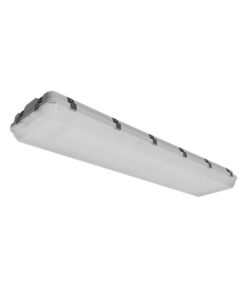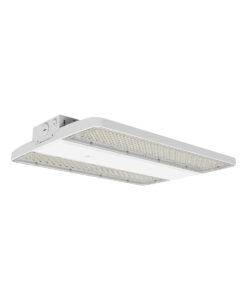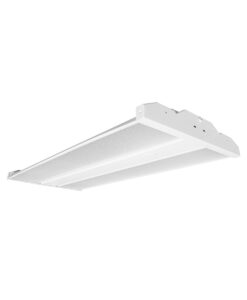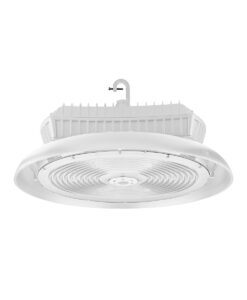Industrial high bay LED light fixtures are revolutionizing the way we illuminate large spaces. These powerful lighting solutions offer unparalleled efficiency and performance for warehouses, factories, and other industrial settings.
At PacLights, we’ve seen firsthand how these fixtures can transform workplaces, boosting productivity and reducing energy costs. In this post, we’ll explore the key features and benefits of LED high bays, helping you make informed decisions for your facility’s lighting needs.
What Are Industrial LED High Bay Fixtures?
Illuminating Large Spaces
Industrial LED high bay fixtures are powerful lighting solutions designed for spaces with high ceilings (typically 20 feet or higher). These fixtures illuminate large areas like warehouses, factories, and distribution centers with bright, uniform light.
The Anatomy of LED High Bay Lights
At the core of every LED high bay fixture is an array of light-emitting diodes (LEDs). These semiconductor devices convert electricity directly into light, which makes them incredibly efficient. The LEDs mount on a heat sink, which dissipates heat and ensures longevity. A driver regulates power to the LEDs, while high-quality optics direct the light where it’s needed most.
LED High Bays vs. Traditional Options
LED high bay fixtures offer significant advantages over their traditional counterparts like metal halide or fluorescent lights. They use up to 60% less energy than a metal halide fixture while providing the same amount of light. This translates to substantial cost savings over time.

Longevity is another key benefit. While metal halide lamps last around 15,000 hours, LED high bays typically operate for 50,000 to 200,000 hours depending on the make/model and type of fixture. This results in less frequent replacements and lower maintenance costs. Many facilities report zero maintenance costs for years after installing LED high bays.
Tailoring Light to Specific Needs
One of the most practical advantages of LED high bays is their versatility. These fixtures come in various color temperatures, typically ranging from 3000K (warm white) to 5000K (cool white). This allows facilities to choose lighting that best suits their specific tasks and environment.
Moreover, LED high bays offer superior color rendering compared to traditional options. With Color Rendering Index (CRI) ratings often exceeding 80, these fixtures provide more accurate color representation. This is important for quality control processes and can significantly improve workplace safety.
Smart Lighting Features
Modern LED high bay fixtures often come equipped with advanced features that further enhance their efficiency. Motion sensors can automatically dim or turn off lights in unoccupied areas, while daylight harvesting systems adjust light output based on available natural light. These smart features can lead to energy savings of up to 80% in some cases.
As we move forward, it’s important to understand how these efficiency features translate into real-world power consumption and cost savings. Let’s explore the energy efficiency and power output of LED high bay fixtures in more detail.
How Efficient Are LED High Bay Fixtures?
Energy Savings That Matter
LED high bay fixtures revolutionize industrial lighting efficiency. These powerhouses outperform traditional solutions in energy consumption, light output, and longevity.

The energy savings from LED high bays are impressive. Studies suggest LED high bay lights convert a far more significant percentage of energy into light than traditional options, providing equal or better illumination while using less energy. This reduction translates to substantial cost savings for facilities using these fixtures.
Superior Illumination and Distribution
LED high bays don’t just save energy; they also deliver exceptional illumination. These fixtures typically produce high lumen outputs, ensuring bright, uniform lighting across large spaces.
The light distribution of LED high bays excels. With precision-engineered optics, they direct light exactly where it’s needed, minimizing wasted light and improving overall visibility. This feature proves particularly valuable in warehouses with high shelving, where vertical illumination is essential for quick label reading and item location.
Longevity That Reduces Costs
The lifespan of LED high bay fixtures impresses, often ranging from 50,000 to 200,000 hours. This extended life span results in significant maintenance savings. While old-style lights need replacement every 15,000 to 25,000 hours, LED high bays can operate for over a decade with minimal upkeep.
A facility that runs lights for 12 hours daily illustrates this difference. Traditional metal halide fixtures would require replacement about every 3-4 years. In contrast, LED high bays could last 11-15 years or more. This reduction in maintenance not only saves on replacement costs but also minimizes operational disruptions.
Real-World Performance Metrics
In practice, the efficiency of LED high bays leads to quick returns on investment. Many facilities report payback periods of 2-3 years, after which the energy savings become pure profit. For example, a manufacturing plant in Ohio replaced 400 metal halide fixtures with LED high bays and saw a 70% reduction in lighting energy costs, with a payback period of just 14 months.
The combination of energy efficiency, superior light quality, and minimal maintenance makes LED high bay fixtures a smart choice for industrial facilities aiming to optimize their lighting systems. As we explore the various options available, it’s important to understand how to select the right LED high bay for specific facility needs. Let’s examine the key factors to consider when choosing the perfect LED high bay for your industrial space.
Selecting Your Ideal LED High Bay
Assessing Your Space
Ceiling height determines the appropriate LED high bay fixture. Lower wattage fixtures (100-150W) suit ceilings between 15 to 25 feet. Higher wattage options (200-400W) illuminate spaces with ceilings exceeding 30 feet adequately.

Space layout influences fixture selection. Open areas need fixtures with wider beam angles. Narrow aisles or spaces with high shelving units require more focused light distribution.
Task requirements matter. Quality control areas need high color rendering index (CRI) fixtures (typically 80+ CRI) to ensure accurate color perception. Assembly lines benefit from higher lumen output fixtures to reduce eye strain and improve productivity.
Optimizing Light Quality
Color temperature impacts the work environment significantly. Cool white (5000K-6500K) promotes alertness and suits task-oriented spaces. Neutral white (3500K-4000K) offers balance and works well in multi-purpose areas.
CRI proves essential for color-critical tasks. Most LED high bays offer a CRI of 70-80. Fixtures with 90+ CRI benefit areas where color accuracy is paramount (such as textile manufacturing or print shops).
Fine-Tuning Light Distribution
Beam angle selection ensures efficient light distribution. Narrow beam angles (15-30 degrees) work well for high ceilings and focused lighting needs. Wider angles (90-120 degrees) suit general illumination in lower-ceiling areas.
Optics control light effectively. Reflectors redirect light to where it’s needed most, while diffusers reduce glare. Some manufacturers offer customizable optics, allowing for tailored light distribution based on specific facility layouts.
Considering Energy Efficiency
Wattage directly affects energy consumption. LED high bay fixtures typically range from 95 to 495 watts. The right wattage depends on the required light output and the space’s dimensions. A 150-watt LED high bay often replaces a 400-watt metal halide fixture while providing similar or better illumination.
Lumens per watt (efficacy) indicate energy efficiency. Modern LED high bays achieve 130-160 lumens per watt or more. Higher efficacy translates to lower energy costs over time.
Evaluating Additional Features
Smart controls enhance efficiency. Motion sensors automatically dim or turn off lights in unoccupied areas. Daylight harvesting systems adjust light output based on available natural light. These features can lead to additional energy savings (up to 80% in some cases).
Durability factors into long-term performance. IP ratings indicate protection against dust and moisture. Higher IP ratings (such as IP65 or IP66) suit harsh industrial environments. Look for fixtures with robust heat management to ensure longevity.
Industrial high bay LED light fixtures have transformed industrial lighting, offering unparalleled benefits in efficiency, performance, and cost-effectiveness. These powerful lighting solutions provide superior illumination while consuming significantly less energy than traditional alternatives. The long lifespan of LED fixtures (often exceeding 50,000 hours) translates to reduced maintenance costs and minimal operational disruptions.

As we look to the future of industrial lighting, we anticipate continued advancements in LED technology. We expect to see even more energy-efficient fixtures, improved smart control systems, and enhanced integration with building management systems. The trend towards sustainable lighting solutions will likely accelerate, with manufacturers focusing on recyclable materials and reduced environmental impact throughout the product lifecycle.
Selecting the right industrial high bay LED light fixtures for your facility impacts energy consumption, operational efficiency, and worker comfort. At PacLights, we understand the complexities of industrial lighting design. Our team of experts can provide valuable insights, helping you navigate the selection process and ensure you choose the most suitable fixtures for your unique requirements.






Disclaimer: PacLights is not responsible for any actions taken based on the suggestions and information provided in this article, and readers should consult local building and electrical codes for proper guidance.